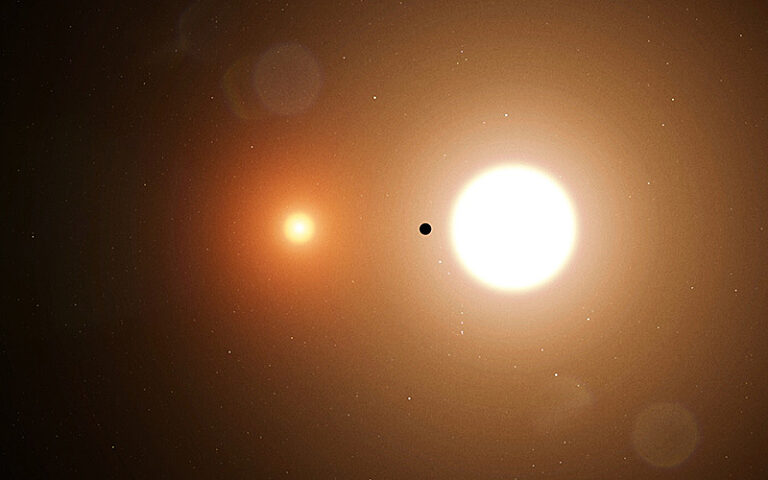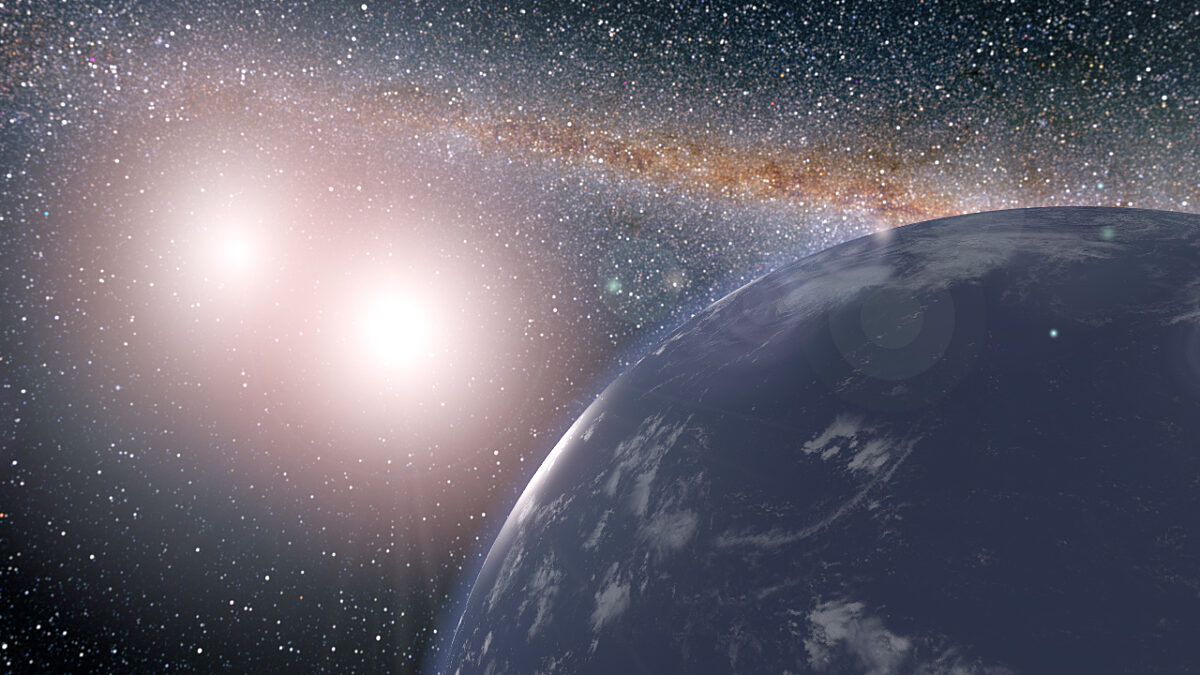Jatan Mehta • Aug 30, 2022
Are planets with two stars promising places for life?
Our search for planets around other stars in our galaxy has led us to discover more than 5,000 worlds. Some of these exoplanets seem to be Earth-like, where surface conditions could sustain liquid water and possibly life as we know it. Even as next-generation telescopes, including the JWST, aim to study atmospheres of such far-off worlds to assess their suitability to host life, our search for habitable worlds remains limited.
Single stars like our Sun aren't the galactic norm; at least half the stars in our Milky Way galaxy exist in pairs as binary stars. Several are trinary or more. It begs the question: could an Earth-sized planet in a favorable orbit around two stars support life?
There are some caveats to this idea, of course. For one thing, it assumes that the way in which the planets formed in our Solar System is applicable to worlds around binary stars. Ample research suggests that Earth-sized worlds might have a hard time even forming in chaotic two-star systems.

The formation conundrum
In our Solar System, Moon-sized protoplanets are thought to have formed within a million years from slowly colliding dust particles in the disk of material orbiting the newborn Sun. Up to hundreds of these worlds collided and combined in the inner Solar System for about 100 million years until only four large bodies remained: Mercury, Venus, Earth, and Mars. But this kind of large-scale accretion may not function for planets around binary stars, which have a hard time forming in the first place.
The gravitational presence of an entire second star makes the disk particles orbit with much higher velocities. Instead of gently sticking on collision, these instead tend to break each other. Based on simulation, scientists think that even when baby planets a few hundred kilometers across form, their high velocities will likely fragment each other on collision.
We’ve already found several planets in binary and even multiple star systems. How do they exist? Are they rogue planets that the combined gravities of binaries capture into orbit when they pass by too closely? In 2021, scientists simulating the nature of protoplanetary disks around newborn binary stars published a more viable explanation: the disk’s gases, like wind, can drag and slow down high-velocity particles and baby planets enough in certain zones to enable them to grow into planets.
Gravity presents another steep barrier for binary star planets. Observations of disks surrounding newborn binary stars by the international ALMA radio telescope array suggest that young binary stars periodically attract more infalling material from their disks than single stars do. This triggers frequent energy outbursts from the stars, which heat up the gas and keep distorting the disk structures. As a result, only certain quieter parts of the disks may be favorable to giant planets accreting.
It gets worse. The pronounced periodic heating of planet-forming disks in binary systems could evaporate substantial water ice and dust on asteroids and comets, and alter the chemistry of their organic molecules — essential ingredients for life as we know it. Considering that scientists think comets and/or asteroids are what brought water and organic materials to early Earth, this would leave the hope for life on binary star planets literally deserted.
The silver lining
In 2017, based on extensive climate modeling, scientists published that an Earth-sized planet in the habitable zone around two Sun-like stars could retain its water for long, and thus presumably be conducive for life to emerge. They found that water vapor clouds in the atmospheres of such planets can persist and regulate temperature variations stemming from the combined gravitational effects of two stars swinging a planet in and out of a circular orbit. Since then, scientists have found more mechanisms that widen habitable zones in such systems.

Moons present another avenue. Saturn’s moon Enceladus has a potentially habitable underground ocean floor, made possible by the warmth from friction between parts of its interior being tugged by Saturn's gravity. Moons around giant planets in binary systems could have similar conditions despite also not residing in the traditional Earth-like habitable zone.
A habitable world right next door?
All of these prospects of finding a two-star habitable world become most intriguing when we consider that the nearest star system to Earth — Alpha Centauri — has a binary pair.
Being just 4.4 light years away, Alpha Centauri’s two Sun-like stars shine brightly in Earth’s southern night skies. Scientists have long been trying to detect planets around the two stars but none of the 5,000 worlds we’ve discovered conclusively belong here.
Our proximity to the bright Alpha Centauri pair hinders our understanding of possible worlds around them. As seen from Earth, the two stars are angled such that light from one pollutes the search for planets around another. The good news is that our increasingly sensitive tools combined with a sufficiently large separation between the two stars from 2022 to 2035 could help astronomers detect any sizable world in the system.

Finding another pale blue dot
The TOLIMAN space telescope developed by the University of Sydney, privately funded by the Breakthrough Initiative along with some support from NASA, is targeting launch in 2023. TOLIMAN will use an advanced technique of astrometry — which is the precise cataloging of the positions, distances, and motions of stars — to find any Earth-sized worlds in the Alpha Centauri system. To reduce mission risk, the team successfully launched the CUAVA-1 CubeSat in August 2021 as a technology demonstration. The team wants to launch the even more sensitive TOLIMAN+ later on to find rocky worlds around further out binary stars.
The possibility of moons of binary star exoplanets harboring life ties back to our Solar System. Some of the biggest planetary science missions launching this decade, like JUICE and Europa Clipper, are dedicated to finding if the underground oceans of Jupiter’s icy moons are habitable. Future mission concepts such as Orbilander would look for direct signs of life on Enceladus. Finding strong life signs on any of these moons would boost the idea of similar life being also possible in binary star systems.
In the meanwhile, both ALMA and JWST can detect some complex chemicals in protoplanetary disks around young binary stars to help scientists determine their abundance and suitability for life as we know it. Future telescopes like the massive Square Kilometer Array and the European Extremely Large Telescope will be able to detect more and larger organic molecules. They will also spot life-conducive chemicals in the atmospheres of two-star planets.
Way back in the 1940s, half a century before the first exoplanet was discovered, Isaac Asimov imagined life being possible on a planet orbiting multiple stars in his novel “Nightfall.” Now, if an Earth-like world is found and imaged right here in our cosmic neighborhood at Alpha Centauri, Carl Sagan’s famous narration of the “Pale Blue Dot” would take on an even greater meaning.


 Explore Worlds
Explore Worlds Find Life
Find Life Defend Earth
Defend Earth

